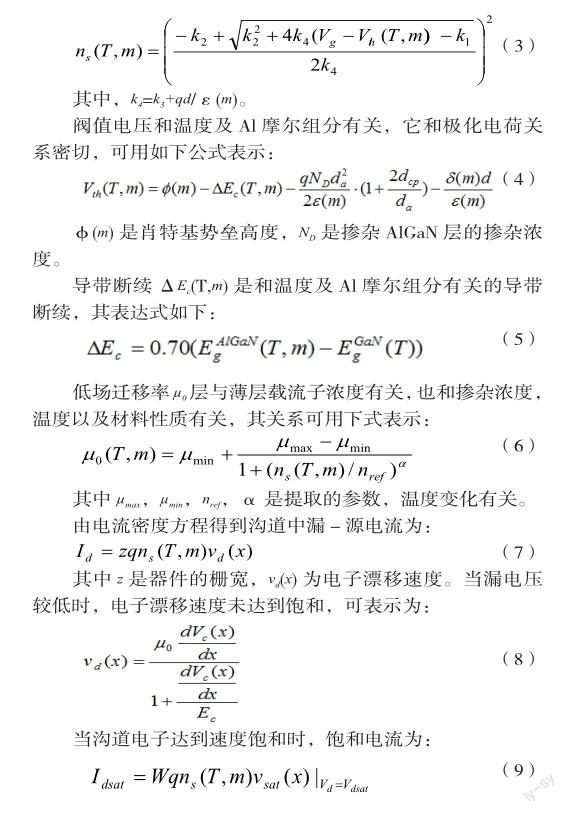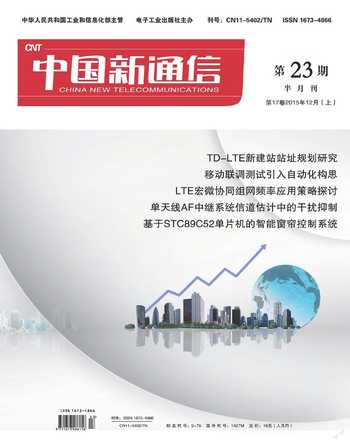热效应对AlGaN/GaN HEMT的影响
姜霞 贾英茜 郭正红 张志伟 唐红梅
【摘要】 分析了載流子迁移率,薄层载流子浓度、饱和电子漂移速度,导带断续,沟道温度等与自热效应的关系,建立了模拟AlGaN/GaN高电子迁移率晶体管直流I-V特性的解析模型。仿真结果同试验结果吻合良好,说明了该模型的正确性。
【关键词】 热效应 AlGaN/GaN HEMT I-V模型
Effects of self-heating on model for AlGaN/GaN HEMT
JIANG Xia1 JIA Ying-qian2 GUO Zheng-hong3 TANG Hong-mei1 ZHANG Zhi-wei1(1.College of Information Engineering, Hebei University of Technology, Tianjin 300130, China, 2.Physical and Electrical Information Engineering Institute, Shijiazhuang University, Shijiazhuang,050000, China,
3.School of Information Science and Engineering, Hebei North University, Zhangjikou 075000,China)
Abstract: A accurate analytical model of I-V characteristics for AlGaN/GaN high electron mobility transistor(HEMT) is presented considering the relationship between self-heating effect and electron mobility, sheet carrier density, velocity saturation, conduction band discontinuity, and channel temperature. The comparison between simulations and physical calculation shows a good agreement, it is prove that this model is accurate.
Key words: Self-heating AlGaN/GaN HEMT I-V model
随着近年来在AlGaN/GaN高电子迁移率晶体管研制方面取得的不断进步,AlGaN/GaN HEMT已经成为在高频、高温和高功率等领域最具发展潜力的电子器件之一,并显示出其优良的电学特性[1,2]。但是当AlGaN/GaN HEMT在较大偏压状态下工作时,过大的功率耗散会导致器件温度的升高,从而加强声子散射,引起势阱中载流子迁移率的下降。这种效应会对器件的静态I-V特性产生重要影响,一般被称作“自热效应”[3]。本文研究了温度的升高对器件参数的影响,建立了模拟AlGaN/GaN HEMT直流I-V特性的热解析模型。最后将模拟结果与实验值进行对比,符合较好。
一、模型及参数

根据电流的连续性,用Vdsat代替式(8)中的Vds,并令式(9)和式(8)相等,可解得饱和点的电压和电流值。
二、结果与分析
根据前面的理论计算公式,结合所选器件参数,首先给出不同衬底材料热导率随温度的变化情况,如图1所示。
由图可知,室温下四种不同的衬底材料SiC,GaN,Si和蓝宝石的热导率随温度的升高而下降,这就使得随着耗散功率的增加,衬底温度会不断上升,产生一系列热效应。由图可见SiC热导率最高,对于GaN器件来说具有明显的优势。
图2给出低场迁移率随薄层载流子浓度及温度的变化规律。由图可知,随着薄层载流子浓度的增加,低场迁移率减小,并且温度越低,变化越明显。
图3描述了SiC衬底时漏电流随漏电压的变化关系。图中空心圆圈代表不考虑自热效应的电流值,实线代表考虑自热效应的电流值,叉字符代表实际的测量值,可以看出该模型的精度较高。
三、结论
研究了“自热效应”对AlGaN/GaN HEMT性能的影响,分析了电子迁移率、薄层载流子浓度、饱和电子漂移速度及导带断续随温度的变化情况,建立了Al0.3Ga0.7N/GaN HEMT的I-V输出特性模型,通过与试验值的对比,该模型具有较高的精度,并且计算过程简单,可以用来指导器件结构和电路的设计。
参 考 文 献
[1] Shen L, Heikman S, Moran B, et al. AlGaN/AlN/GaN higher power microwave HEMT [J]. IEEE Electron Device Lett., 2001, 22(3): 457-459.
[2] Jeong P, Moo W S, Chin C L, et al. Thermal modeling and measurement of AlGaN-GaN HFETs built on sapphire and SiC substrates[J]. IEEE Trans Electron Device, 2004,51(11):1753-1759.
[3] Manju K C, Sanjiv T. Temperature and polarization dependent polynomial based non-linear analytical model for gate capacitance of AlGaN/GaN MODFET[J]. Solid-State Electronics, 2006, 50:220-227.
[4] Chang Y, Zhang Y, Tong K Y. A thermal model for static current characteristics of AlGaN/GaN high electron mobility transistors including selfheating effect [J]. J. Appl. Phys, 2006, 99: 445-451.
[5] S. Nuttinck, Brent K. Wangner, Bhaskar Banerjee. Thermal analysis of AlGaN-GaN power HFET[J]. IEEE Trans Microwave Theory and Techniques. 2003,51(12):2445-2451
[6] Manju K. Chattopadhyay, Sanjiv Tokerar. Temperation and polarization dependent polynomial besed non-linear analytical model for gate capacitance of AlGaN/GaN MODFET. Solid-State Electronics.2006, 50:220-227

